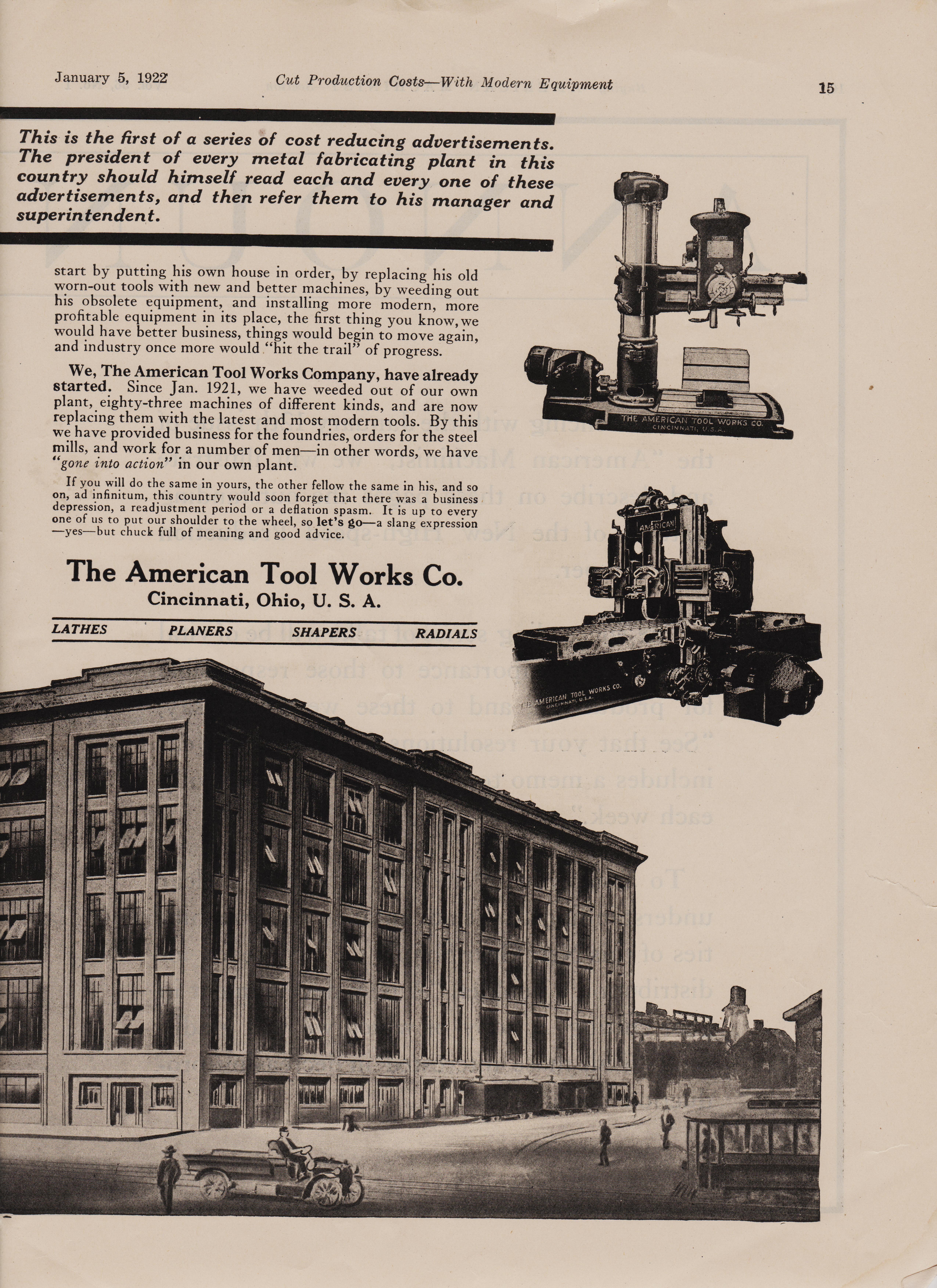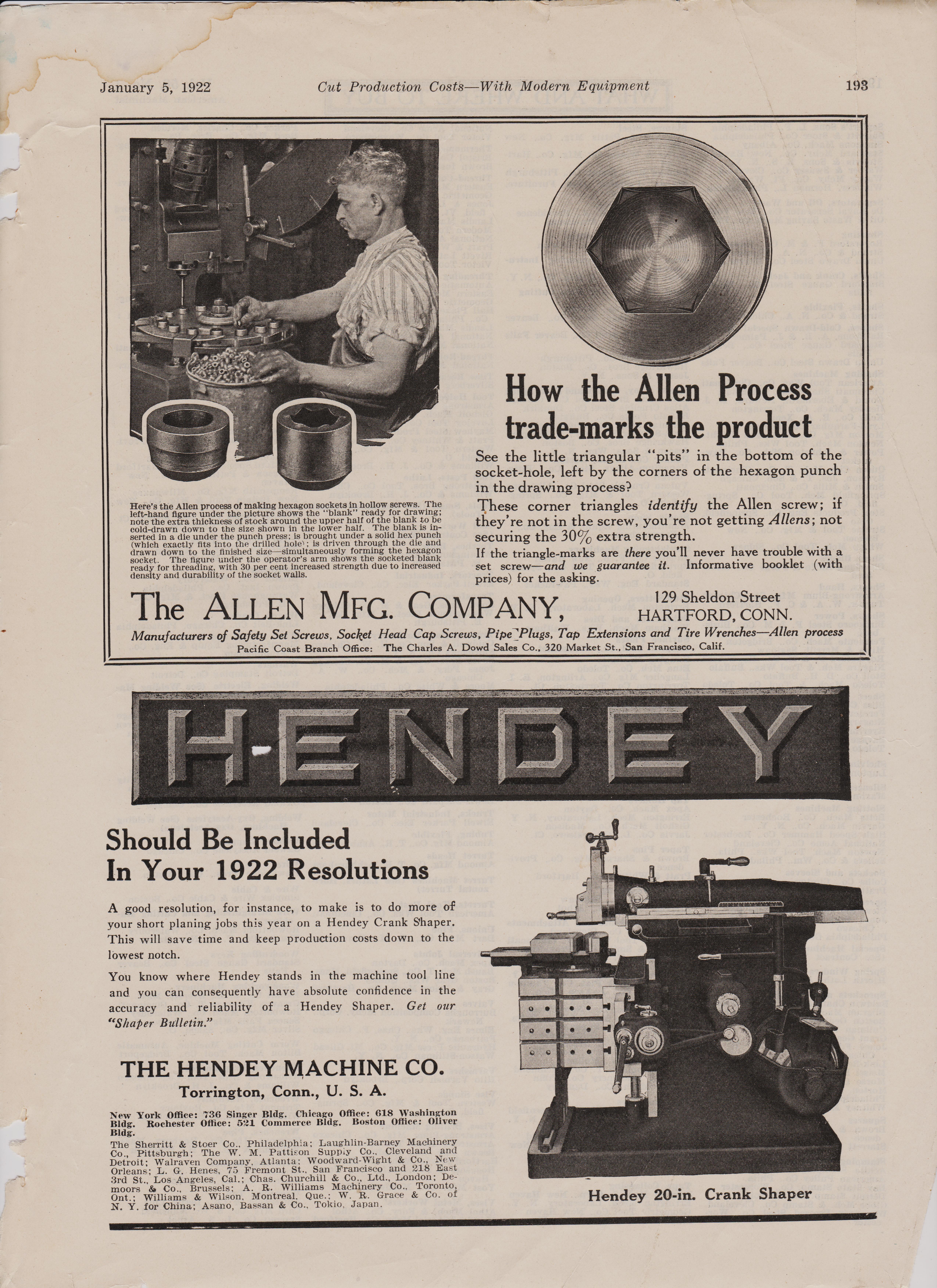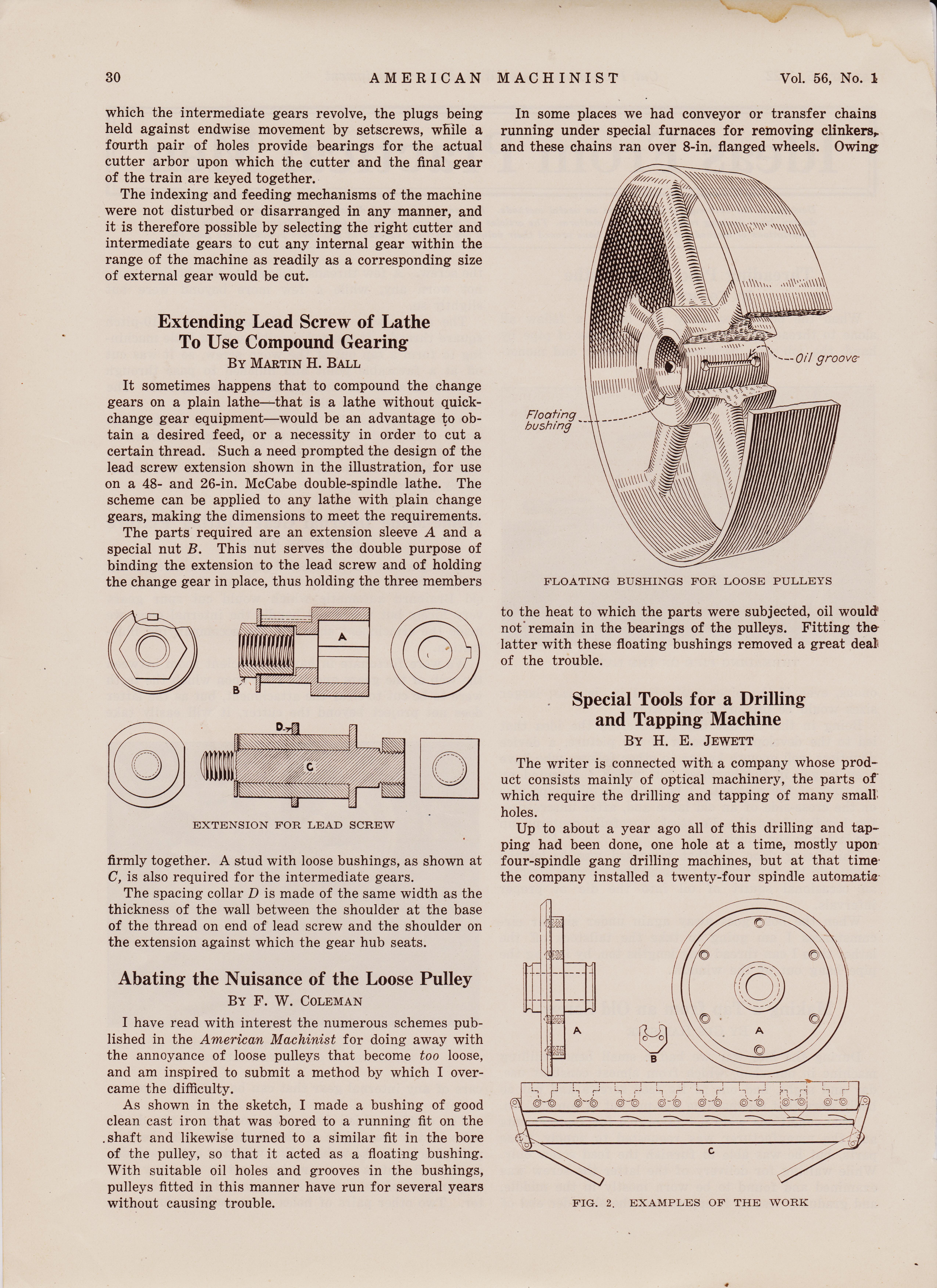
test 5 58 AMERICAN I C AN MACHINIST Section Vol. 56, No. 1 Original in every respect with numerous new features Designed for High-Speed Drills Write for printed matter telling the whole story Dreses Machine Tool Company, Cincinnati, Ohio Exceptional Service REED-PRENTICE Radials insure this because of the convenient location of all operating levers, the quickness with which speed changes can be made and the positive rigidity secured by the use of the box type column. They are built in 272 ft., 3 ft., 4 ft. and 5 ft. sizes and can be arranged for either variable or constant speed motor drive. LATHES—PLANERS—MILLING MACHINES—MILLING CUTTERS RADIAL DRILLS-VERTICAL SURFACE GRINDERS-PORTABLE SHAPERS RECKER- !LUNG EED-PRENTICE O. HITCOMB-RLAISDEM-\' LI MACHINE COMPANY I MACHINE TOOL CO. 677 CAMBRIDGE STREET, WORCESTER, MASS. Sales Offices: Cleveland, Indianapolis, Detroit, New York. Agents: Dale Ma- Whitcomb-Blaisdell Agents only: Fairbanks Co., Pittsburgh and St. Louis ; chinery Co., Chicago, Ill.; NormoYle & Lapp, 514 Liberty Bldg., Philadelphia, Badger, Packard Machinery Co., Milwaukee, Wis. Becker Agents only: F. .E. Pa. ; M. D. Larkin Supply Co., Dayton, Ohio ; 0. R. Adams, Buffalo and Satterlee Co., Minneapolis, Minn. Cutter Agents: J. L. Stone-Leidy Co., Ma-Rochester, N. Y. ; H. A. Smith Machinery Co., Syracuse, N. Y. ; W. M. Pattison chinery Hall, Chicago; M. D. Larkin Supply Co., Dayton, Ohio; NOrmoyle & Supply Co., Cleveland, 011ie; McCoy-Brandt Machinery Co., Pittsburgh, Pa. Lapp, 514 Liberty Building,
58
AMERICAN I C AN MACHINIST Section
Vol. 56, No. 1
Original in every respect with numerous new features Designed for High-Speed Drills Write for printed matter telling the whole story Dreses Machine Tool Company, Cincinnati, Ohio
Exceptional Service
REED-PRENTICE Radials insure this because of the convenient location of all operating levers, the quickness with which speed changes can be made and the positive rigidity secured by the use of the box type column.
They are built in 272 ft., 3 ft., 4 ft. and 5 ft. sizes and can be arranged for either variable or constant speed motor drive.
LATHES—PLANERS—MILLING MACHINES—MILLING CUTTERS RADIAL DRILLS-VERTICAL SURFACE GRINDERS-PORTABLE SHAPERS
RECKER- !LUNG EED-PRENTICE O. HITCOMB-RLAISDEM-\' LI MACHINE COMPANY I MACHINE TOOL CO.
677 CAMBRIDGE STREET, WORCESTER, MASS.
Sales Offices: Cleveland, Indianapolis, Detroit, New York. Agents: Dale Ma- Whitcomb-Blaisdell Agents only: Fairbanks Co., Pittsburgh and St. Louis ; chinery Co., Chicago, Ill.; NormoYle & Lapp, 514 Liberty Bldg., Philadelphia, Badger, Packard Machinery Co., Milwaukee, Wis. Becker Agents only: F. .E. Pa. ; M. D. Larkin Supply Co., Dayton, Ohio ; 0. R. Adams, Buffalo and Satterlee Co., Minneapolis, Minn. Cutter Agents: J. L. Stone-Leidy Co., Ma-Rochester, N. Y. ; H. A. Smith Machinery Co., Syracuse, N. Y. ; W. M. Pattison chinery Hall, Chicago; M. D. Larkin Supply Co., Dayton, Ohio; NOrmoyle & Supply Co., Cleveland, 011ie; McCoy-Brandt Machinery Co., Pittsburgh, Pa. Lapp, 514 Liberty Building, Philadelphia, Pa. Sales Offices and Agents have stock of cutters for prompt deliveries
Philadelphia, Pa. Sales Offices and Agents have stock of cutters for prompt deliveries

AMERICAN I C AN MACHINIST Section Vol. 56, No. 1 Original in every respect with numerous new features Designed for High-Speed Drills Write for printed matter telling the whole story Dreses Machine Tool Company, Cincinnati, Ohio Exceptional Service REED-PRENTICE Radials insure this because of the convenient location of all operating levers, the quickness with which speed changes can be made and the positive rigidity secured by the use of the box type column. They are built in 272 ft., 3 ft., 4 ft. and 5 ft. sizes and can be arranged for either variable or constant speed motor drive. LATHES—PLANERS—MILLING MACHINES—MILLING CUTTERS RADIAL DRILLS-VERTICAL SURFACE GRINDERS-PORTABLE SHAPERS RECKER- !LUNG EED-PRENTICE O. HITCOMB-RLAISDEM-\' LI MACHINE COMPANY I MACHINE TOOL CO. 677 CAMBRIDGE STREET, WORCESTER, MASS. Sales Offices: Cleveland, Indianapolis, Detroit, New York. Agents: Dale Ma- Whitcomb-Blaisdell Agents only: Fairbanks Co., Pittsburgh and St. Louis ; chinery Co., Chicago, Ill.; NormoYle & Lapp, 514 Liberty Bldg., Philadelphia, Badger, Packard Machinery Co., Milwaukee, Wis. Becker Agents only: F. .E. Pa. ; M. D. Larkin Supply Co., Dayton, Ohio ; 0. R. Adams, Buffalo and Satterlee Co., Minneapolis, Minn. Cutter Agents: J. L. Stone-Leidy Co., Ma-Rochester, N. Y. ; H. A. Smith Machinery Co., Syracuse, N. Y. ; W. M. Pattison chinery Hall, Chicago; M. D. Larkin Supply Co., Dayton, Ohio; NOrmoyle & Supply Co., Cleveland, 011ie; McCoy-Brandt Machinery Co., Pittsburgh, Pa. Lapp, 514 Liberty Building,
58
AMERICAN MACHINIST Section Vol. 56, No. 1
Original in every respect with numerous new features Designed for High-Speed Drills Write for printed matter telling the whole story Dreses Machine Tool Company, Cincinnati, Ohio
Exceptional Service
REED-PRENTICE Radials insure this because of the convenient location of all operating levers, the quickness with which speed changes can be made and the positive rigidity secured by the use of the box type column.
They are built in 272 ft., 3 ft., 4 ft. and 5 ft. sizes and can be arranged for either variable or constant speed motor drive.
LATHES—PLANERS—MILLING MACHINES—MILLING CUTTERS RADIAL DRILLS-VERTICAL SURFACE GRINDERS-PORTABLE SHAPERS
RECKER- !LUNG EED-PRENTICE O. HITCOMB-RLAISDEM-\' LI MACHINE COMPANY I MACHINE TOOL CO.
677 CAMBRIDGE STREET, WORCESTER, MASS.
Sales Offices: Cleveland, Indianapolis, Detroit, New York. Agents: Dale Ma- Whitcomb-Blaisdell Agents only: Fairbanks Co., Pittsburgh and St. Louis ; Machinery Co., Chicago, Ill.; NormoYle & Lapp, 514 Liberty Bldg., Philadelphia, Badger, Packard Machinery Co., Milwaukee, Wis. Becker Agents only: F. .E. Pa. ; M. D. Larkin Supply Co., Dayton, Ohio ; 0. R. Adams, Buffalo and Satterlee Co., Minneapolis, Minn. Cutter Agents: J. L. Stone-Leidy Co., Ma-Rochester, N. Y. ; H. A. Smith Machinery Co., Syracuse, N. Y. ; W. M. Pattison chinery Hall, Chicago; M. D. Larkin Supply Co., Dayton, Ohio; NOrmoyle & Supply Co., Cleveland, 011ie; McCoy-Brandt Machinery Co., Pittsburgh, Pa. Lapp, 514 Liberty Building, Philadelphia, Pa. Sales Offices and Agents have stock of cutters for prompt deliveries
January 12, 1922
25 cents a copy
American Machinist
KENNETH H. CONDIT and FRED H. COLVIN, Editors L. C. MORROW, Managing Editor Associate Editors—S. ASHTON HAND C. J. PRIEBE ELLSWORTH SHELDON, New England Editor HOWARD CAMPBELL, Western Editor, Chicago MASON BRITTON, Manager
CO1ATTENTS
Manufacture and Use of Diamond Cutting Tools 53 BY ELLSWORTH SHELDON. THE MANUFACTURE OF TOOLS with cutting edges of diamond crystals, and some uses to which they are adaoted. American Machinist, Vol. 56. Laying Out a Factory for Production Work 56 BY FRANK W. CURTIS. GIVING DETAILS of the methods used in laying out a plant for production work. American Machinist, Vol. 56. Automotive Service Methods and Equipment 59 BY HOWARD CAMPBELL. THE SIXTH OF A SERIES OF ARTICLES dealing with the tools and methods in some of the larger automotive service plants. American Machinist, Vol. 56.
Programs of Apprenticeship—XVIII 62 BY J. V. L. MORRIS. A DESCRIPTION of the system employed for instructing ma-chinist apprentices in the shops of a large railroad. This system is of particular interest because the shops of the concern are widely scattered and in localities where there are not many mechanics. American Machinist, Vol. 56 The Grinding Machine in the Railroad Shop 64 BY FRANK A. STANLEY, A DISCUSSION of the advantages to be derived from the use of the grinding machine for finishing locomotive parts. American Machinist, Vol. 56. Tool Engineering 67 By ALBERT A. DOWD AND FRANK W. CURTIS. A DISCUSSION of the principles and practices involved in the design of boring tools for turret lathe use, the article being the thirty-third of a series dealing with jig and tool design. American Machinist, Vol. 56. Making a Casehardened Crankshaft 72 SPECIAL CORRESPONDENCE. A METHOD of securing a very hard bearing surface while preventing the shaft from springing. American Machinist, Vol. 56.
Searchlight Section 98 Contract Work 108 What and Where to Buy 112 Advertising Index 124
Machine Tool Industry May Utilize Its Idle Equipment 73 By FRANK A. SCOTT. READJUSTMENT WILL BRING DEMAND for more and better ma-chine tools to lower production costs. American Machinist, Vol. 56.
Ideas from Practical Men 76 SIMPLE FIXTURE FOR HAND TAPPING, Phelps-Holding a Bor-ing Bar in a Radial Drilling Machine, Hammond-Increasing the Capacity of a Milling Machine Vise, Holbrook-A Safety Screwdriver for Use Around the Screw Machine, Moore-How to Rivet Properly, Bryant-Quick Method of Refinish-ing the Measuring Surfaces of Micrometers, Reimschissel-Center Drill Used for Spotting, Haessler-A Shop Man's Method of Figuring Change Gears, Crommell-Kink That Saves Trouble in Putting on Lathe Chuck. Knabe-Chuck for Refinishing Standard Piercing Punches, Harger-Handy Lo-cating Device for the Milling Machine, Johnson-Lapping a Pitted Journal to Make It True, Clock-Jig for Drilling Crossholes in Round Stock, Haessler, American Machinist, Vol. 56.
Editorials 80 THE AMERICAN VALUATION PLAN-A National Engineering Research Laboratory? American, Machinist, Vol. 56.
Shop Equipment News 81 STEWART FURNACES AND FORGES-Watson-Still/ran Forcing Press-Oliver No. 65 Self-Feed Rip Saw-Improvements in the "Photostat"-Hisey "Super" Universal Portable Electric Drill-Atlas "Junior" Dial Indicator. American Machinist, Vol. 56.
Miscellaneous Articles Siam Can Use Steel Plows Specifications for Brass and Bronze Gears Kinks for the Machine Shop, Mcfrenry American Machinist, Vol. 56.
Coming Features The Training of Workers in Manufacture—J. V. L. Morris Modern Production Methods—Wm. R. Basset Design of Bevel, Helical and Worm Involute Gears—A. B. Cox Manufacturing Parts of Northway Trucks—Robert Mawson Hydraulic and Hand-Forcing Presses in a Locomotive Shop—J. V. Hunter The articles listed above are to appear in the next issue.
News Section 84a
The Business Barom-eter 84c By THEODORE H. PRICI,
Weekly Price Guide, Shop Materials and Supplies 84n and o
New and Enlarged Shops 84m and p
JAMES H. McGRAW President
ARTHUR J. BALDWIN Vice President
J. MALCOLM MUIR EDWARD D. CONKLIN Vice President Vice President
JAMES H. McGRAW, Secretary and Treasurer
McGRAW-HILL COMPANY, INC.,St., Tenth Ave. at 36th St NEW YORK
Publishers also of Electrical World-Electrical Merchandising-Power-Engineering News-Record--Engineering and Mining Journal-Chemical and Metallurgical Engineering-Electric Railway Journal-Coal Age-Journal of Electricity and Western Industry-Ingeneria Internacional Change of Address-When change of address is ordered the new and the old address must be given. Notice must be received at least ten days before the change takes place. Copyright, 1921, 1VIcGra w-Hitl Company, Inc. Published weekly. Entered as second-class matter June 23, 1879, at the Post Office at New York, under the Act of March 3, 1879. Printed in U. S. A. Member Associated Business Papers, Inc. Circulation of This Issue, 19,847 Member Audit Bureau of Circulations.
Annual subscription rate, $5 in any part of the United States, Canada, Mexico, Alaska, Hawaii, the Philippines, Porto Rico, Canal Zone, Cuba, Panama.. Dominican Republic, Honduras, Salvador, Nicaragua, Peru, Colombia, Bolivia and Shanghai, China. Extra postage on American Edition in ,other countries except Europe and British pos-sessions in Eastern Hemisphere, $4 (total, $9 or 38 shillings) Single copy 25 cents. McGraw-Hill Publishing Co., Ltd., 6 Bouverie St., London. E. C. 4, England, will serve with the European Edition all subscribers in Europe and British possessions in Eastern Hemisphere (40 shillings for England and 45 shillings elsewhere in Eastern Hemisphere.)
WASHINGTON, D. C.. Colorado Building CHICAGO. 1570 Old Colony Bldg. PHILADELPHIA, Real Estate Trust Bldg. CLEVELAND. Leader-News Bldg. ST. LOUIS, 713 Star Bldg. SAN FRANCISCO. Rialto Bldg. LONDON. E. C., 6 Bouverie St.
Cable Address : "Machinist, N. Y."
start again here
2-20-24

January 12, 1922
25 cents a copy
American Machinist
Miscellaneous Articles Siam Can Use Steel Plows Specifications for Brass and Bronze Gears Kinks for the Machine Shop, Mcfrenry American Machinist, Vol. 56.
Coming Features The Training of Workers in Manufacture—J. V. L. Morris Modern Production Methods—Wm. R. Basset Design of Bevel, Helical and Worm Involute Gears—A. B. Cox Manufacturing Parts of Northway Trucks—Robert Mawson Hydraulic and Hand-Forcing Presses in a Locomotive Shop—J. V. Hunter The articles listed above are to appear in the next issue.

January 12, 1922
25 cents a copy
American Machinist
Miscellaneous Articles Siam Can Use Steel Plows Specifications for Brass and Bronze Gears Kinks for the Machine Shop, Mcfrenry American Machinist, Vol. 56.
Coming Features The Training of Workers in Manufacture—J. V. L. Morris Modern Production Methods—Wm. R. Basset Design of Bevel, Helical and Worm Involute Gears—A. B. Cox Manufacturing Parts of Northway Trucks—Robert Mawson Hydraulic and Hand-Forcing Presses in a Locomotive Shop—J. V. Hunter The articles listed above are to appear in the next issue.

January 12, 1922
25 cents a copy
American Machinist
Miscellaneous Articles Siam Can Use Steel Plows Specifications for Brass and Bronze Gears Kinks for the Machine Shop, Mcfrenry American Machinist, Vol. 56.
Coming Features The Training of Workers in Manufacture—J. V. L. Morris Modern Production Methods—Wm. R. Basset Design of Bevel, Helical and Worm Involute Gears—A. B. Cox Manufacturing Parts of Northway Trucks—Robert Mawson Hydraulic and Hand-Forcing Presses in a Locomotive Shop—J. V. Hunter The articles listed above are to appear in the next issue.

January 12, 1922
25 cents a copy
American Machinist
Miscellaneous Articles Siam Can Use Steel Plows Specifications for Brass and Bronze Gears Kinks for the Machine Shop, Mcfrenry American Machinist, Vol. 56.
Coming Features The Training of Workers in Manufacture—J. V. L. Morris Modern Production Methods—Wm. R. Basset Design of Bevel, Helical and Worm Involute Gears—A. B. Cox Manufacturing Parts of Northway Trucks—Robert Mawson Hydraulic and Hand-Forcing Presses in a Locomotive Shop—J. V. Hunter The articles listed above are to appear in the next issue.

8
January 12, 1922
25 cents a copy
American Machinist
Miscellaneous Articles Siam Can Use Steel Plows Specifications for Brass and Bronze Gears Kinks for the Machine Shop, Mcfrenry American Machinist, Vol. 56.
Coming Features The Training of Workers in Manufacture—J. V. L. Morris Modern Production Methods—Wm. R. Basset Design of Bevel, Helical and Worm Involute Gears—A. B. Cox Manufacturing Parts of Northway Trucks—Robert Mawson Hydraulic and Hand-Forcing Presses in a Locomotive Shop—J. V. Hunter The articles listed above are to appear in the next issue.

January 12, 1922
25 cents a copy
American Machinist
Miscellaneous Articles Siam Can Use Steel Plows Specifications for Brass and Bronze Gears Kinks for the Machine Shop, Mcfrenry American Machinist, Vol. 56.
Coming Features The Training of Workers in Manufacture—J. V. L. Morris Modern Production Methods—Wm. R. Basset Design of Bevel, Helical and Worm Involute Gears—A. B. Cox Manufacturing Parts of Northway Trucks—Robert Mawson Hydraulic and Hand-Forcing Presses in a Locomotive Shop—J. V. Hunter The articles listed above are to appear in the next issue.
























